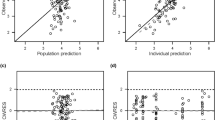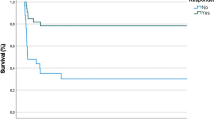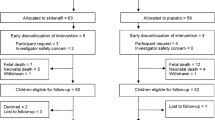Abstract
Objective
To characterize the safety of sildenafil in premature infants.
Study design
A phase I, open-label trial of sildenafil in premature infants receiving sildenafil per usual clinical care (cohort 1) or receiving a single IV dose of sildenafil (cohort 2). Safety was evaluated based on adverse events (AEs), transaminase levels, and mean arterial pressure monitoring.
Results
Twenty-four infants in cohort 1 (n = 25) received enteral sildenafil. In cohort 2, infants received a single IV sildenafil dose of 0.25 mg/kg (n = 7) or 0.125 mg/kg (n = 2). In cohort 2, there was one serious AE related to study drug involving hypotension associated with a faster infusion rate than specified by the protocol. There were no AEs related to elevated transaminases.
Conclusion
Sildenafil was well tolerated by the study population. Drug administration times and flush rates require careful attention to prevent infusion-related hypotension associated with faster infusions of IV sildenafil in premature infants.
Clinical trial
ClinicalTrials.gov Identifier: NCT01670136.
This is a preview of subscription content, access via your institution
Access options
Subscribe to this journal
Receive 12 print issues and online access
$259.00 per year
only $21.58 per issue
Buy this article
- Purchase on SpringerLink
- Instant access to full article PDF
Prices may be subject to local taxes which are calculated during checkout

Similar content being viewed by others
References
Mourani PM, Sontag MK, Younoszai A, Miller JI, Kinsella JP, Baker CD, et al. Early pulmonary vascular disease in preterm infants at risk for bronchopulmonary dysplasia. Am J Respir Crit Care Med. 2015;191:87–95.
Collaco JM, Dadlani GH, Nies MK, Leshko J, Everett AD, McGrath-Morrow SA. Risk factors and clinical outcomes in preterm infants with pulmonary hypertension. PLoS One. 2016;11:e0163904.
An HS, Bae EJ, Kim GB, Kwon BS, Beak JS, Kim EK, et al. Pulmonary hypertension in preterm infants with bronchopulmonary dysplasia. Korean Circ J. 2010;40:131–6.
Khemani E, McElhinney DB, Rhein L, Andrade O, Lacro RV, Thomas KC, et al. Pulmonary artery hypertension in formerly premature infants with bronchopulmonary dysplasia: clinical features and outcomes in the surfactant era. Pediatrics. 2007;120:1260–9.
Slaughter JL, Pakrashi T, Jones DE, South AP, Shah TA. Echocardiographic detection of pulmonary hypertension in extremely low birth weight infants with bronchopulmonary dysplasia requiring prolonged positive pressure ventilation. J Perinatol. 2011;31:635–40.
Jackson W, Hornik CP, Messina JA, Guglielmo K, Watwe A, Delancy G, et al. In-hospital outcomes of premature infants with severe bronchopulmonary dysplasia. J Perinatol. 2017;37:853–6.
Kim DH, Kim HS, Choi CW, Kim EK, Kim BI, Choi JH. Risk factors for pulmonary artery hypertension in preterm infants with moderate or severe bronchopulmonary dysplasia. Neonatology. 2012;101:40–6.
Bhat R, Salas AA, Foster C, Carlo WA, Ambalavanan N. Prospective analysis of pulmonary hypertension in extremely low birth weight infants. Pediatrics. 2012;129:e682–9.
Bruno CJ, Meerkov M, Capone C, Vega M, Sutton N, Kim M, et al. CRIB scores as a tool for assessing risk for the development of pulmonary hypertension in extremely preterm infants with bronchopulmonary dysplasia. Am J Perinatol. 2015;32:1031–7.
Shankaran S, Laptook AR, Pappas A, McDonald SA, Das A, Tyson JE, et al. Effect of depth and duration of cooling on death or disability at age 18 months among neonates with hypoxic-ischemic encephalopathy: a randomized clinical trial. JAMA. 2017;318:57–67.
Ahsman MJ, Witjes BC, Wildschut ED, Sluiter I, Vulto AG, Tibboel D, et al. Sildenafil exposure in neonates with pulmonary hypertension after administration via a nasogastric tube. Arch Dis Child Fetal Neonatal Ed. 2010;95:F109–14.
Thompson EJ, Perez K, Hornik CP, Smith PB, Clark RH, Laughon M. Sildenafil exposure in the neonatal intensive care unit.Am J Perinatol. 2019;36:262–7.
Gonzalez D, Laughon MM, Smith PB, Ge S, Ambalavanan N, Atz A, et al. Population pharmacokinetics of sildenafil in extremely premature infants. Br J Clin Pharmacol. 2019;85:2824–37.
Fujioka K, Shibata A, Yokota T, Koda T, Nagasaka M, Yagi M, et al. Association of a vascular endothelial growth factor polymorphism with the development of bronchopulmonary dysplasia in Japanese premature newborns. Sci Rep. 2014;4:4459.
Yun EJ, Lorizio W, Seedorf G, Abman SH, Vu TH. VEGF and endothelium-derived retinoic acid regulate lung vascular and alveolar development. Am J Physiol Lung Cell Mol Physiol. 2016;310:L287–98.
Jobe AH. The new bronchopulmonary dysplasia. Curr Opin Pediatr. 2011;23:167–72.
Konig K, Barfield CP, Guy KJ, Drew SM, Andersen CC. The effect of sildenafil on evolving bronchopulmonary dysplasia in extremely preterm infants: a randomised controlled pilot study. J Matern Fetal Neonatal Med. 2014;27:439–44.
Mourani PM, Sontag MK, Ivy DD, Abman SH. Effects of long-term sildenafil treatment for pulmonary hypertension in infants with chronic lung disease. J Pediatr. 2009;154:379–84. 84.e1-2.
21 CFR Sec. 50.53 Clinical investigations involving greater than minimal risk and no prospect of direct benefit to individual subjects, but likely to yield generalizable knowledge about the subjects’ disorder or condition. 2015.
Tromp K, Zwaan CM, van de Vathorst S. Motivations of children and their parents to participate in drug research: a systematic review. Eur J Pediatr. 2016;175:599–612.
Laughon MM, Benjamin DK Jr., Capparelli EV, Kearns GL, Berezny K, Paul IM, et al. Innovative clinical trial design for pediatric therapeutics. Expert Rev Clin Pharm. 2011;4:643–52.
Watt KM, Benjamin DK Jr., Cheifetz IM, Moorthy G, Wade KC, Smith PB, et al. Pharmacokinetics and safety of fluconazole in young infants supported with extracorporeal membrane oxygenation. Pediatr Infect Dis J. 2012;31:1042–7.
Gonzalez D, Delmore P, Bloom BT, Cotten CM, Poindexter BB, McGowan E, et al. Clindamycin pharmacokinetics and safety in preterm and term infants. Antimicrob Agents Chemother. 2016;60:2888–94.
Cohen-Wolkowiez M, Sampson M, Bloom BT, Arrieta A, Wynn JL, Martz K, et al. Determining population and developmental pharmacokinetics of metronidazole using plasma and dried blood spot samples from premature infants. Pediatr Infect Dis J. 2013;32:956–61.
Cohen-Wolkowiez M, Benjamin DK Jr., Ross A, James LP, Sullivan JE, Walsh MC, et al. Population pharmacokinetics of piperacillin using scavenged samples from preterm infants. Ther Drug Monit. 2012;34:312–9.
Beam KS, Aliaga S, Ahlfeld SK, Cohen-Wolkowiez M, Smith PB, Laughon MM. A systematic review of randomized controlled trials for the prevention of bronchopulmonary dysplasia in infants. J Perinatol. 2014;34:705–10.
US Food and Drug Administration. General Clinical Pharmacology Considerations. Guidance for Industry. 2014. https://www.fda.gov/downloads/Drugs/GuidanceComplianceRegulatoryInformation/Guidances/UCM425885.pdf.
Hornik CP, Onufrak NJ, Smith PB, Cohen-Wolkowiez M, Laughon MM, Clark RH, et al. Association between oral sildenafil dosing, predicted exposure, and systemic hypotension in hospitalised infants. Cardiol Young. 2018;28:85–92.
Acknowledgements
Best Pharmaceuticals for Children Act—Pediatric Trials Network Steering Committee: Danny Benjamin, Edmund Capparelli, Erin Campbell, Greg Kearns, Ian Paul, Julie Autmizguine, Kanecia Zimmerman, Kelly Wade, Perdita Taylor-Zapata, Peter Hoffmann, Ravander Anand, Tom Green.
Funding
Eunice Kennedy Shriver National Institute of Child Health and Human Development, Grant/Award Number: HHSN275201000003I.
Author information
Authors and Affiliations
Consortia
Contributions
DG, PBS, NA, AMA, GMS, DS, GM, BBP, SKA, MM, MCW, CPH, MML: Designed the study and enrolled infants in the trial. KM: Performed the analysis. WJ: Wrote the first draft of the manuscript. DG, PBS, NA, AMA, GMS, CDH, DS, GM, BBP, SKA, MM, MCW, KM, CPH, and MML: Reviewed and made significant edits to the manuscript.
Corresponding author
Ethics declarations
Competing interests
The authors declare no competing interests.
Additional information
Publisher’s note Springer Nature remains neutral with regard to jurisdictional claims in published maps and institutional affiliations.
Rights and permissions
About this article
Cite this article
Jackson, W., Gonzalez, D., Smith, P.B. et al. Safety of sildenafil in extremely premature infants: a phase I trial. J Perinatol 42, 31–36 (2022). https://doi.org/10.1038/s41372-021-01261-w
Received:
Revised:
Accepted:
Published:
Issue date:
DOI: https://doi.org/10.1038/s41372-021-01261-w
This article is cited by
-
Pulmonary vasodilator use in very preterm infants in United States children’s hospitals
Journal of Perinatology (2025)
-
Childhood outcomes after maternal antenatal sildenafil treatment for severe early-onset fetal growth restriction: a randomized trial (STRIDER NZAus)
Journal of Perinatology (2024)
-
Multi-dose enteral L-citrulline administration in premature infants at risk of developing pulmonary hypertension associated with bronchopulmonary dysplasia
Journal of Perinatology (2024)
-
The vascular phenotype of BPD: new basic science insights—new precision medicine approaches
Pediatric Research (2024)



